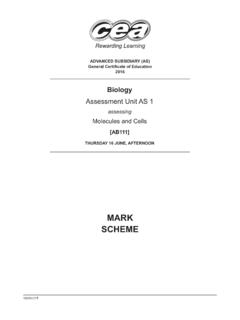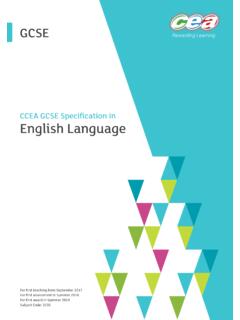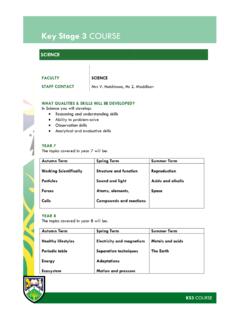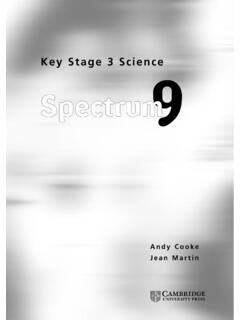Transcription of Key Stage 3 - ccea.org.uk
1 Bones and the SkeletonBBBoonBednd tdhee keetetBBoonend thhee SSkkeeleettoBoBekBoBonnnnnnnnnnenndethSk kSeBkeBKey Stage 3 Bones and the SkeletonKey Stage 32 Suggested Year: 9 or 10 This unit introduces the human skeleton and compares it with the skeletons of other mammals. It explores the structure, shape and name of bones and how this information can be used when investigating crimes. It also explores how this information can be used when looking for clues about remains discovered at an archaeological dig or the lifestyle of a recently deceased person. The unit is suitable for pupils at the end of Year 9 or in Year 10. Some pupils may find articles or discussions about crimes distressing.
2 Teachers should use their personal and professional knowledge when choosing appropriate activities and topic covered in this unit Organisms and HealthUnit links to the Big PictureLearning for Life and Work Personal Development Home Economics Employability Key Elements Personal health Citizenship Cultural understanding Media awarenessCross-Curricular Skills Using Mathematics CommunicationThinking Skills and Personal Capabilities Thinking, Problem Solving, Decision Making Working with OthersLearning Experiences Investigating and problem solving Linked to other curriculum areas Art and Design Relevant and enjoyable Media rich Bones and the SkeletonKey Stage 33 Assessment for Learning Clear learning intentions shared with pupils Celebrate success against agreed success criteria Peer and self-evaluation of learningAttitudes and Dispositions Personal responsibility Concern for others CuriosityClassroom ActivitiesActivity 2:Skeleton Features and Identification Activity 1:The Structure of the Mammalian SkeletonActivity 4:The Importance of CalciumActivity 3.
3 Investigating the Structure of a BoneActivity 6:EvaluationActivity 5:Jobs and CareersBones and the SkeletonKey Stage 34 Activity 1: The Structure of the Mammalian SkeletonLearning IntentionsPupils are learning to recognise the human skeleton and describe the similarities between it and the skeleton of other ActivitiesPut the pupils into groups of four or five to start a Know Want to Know Learned (KWL) exercise (outlined in the Active Learning and Teaching Methods booklet) about the skeleton. Display the pages for each group in the classroom until the end of the a model skeleton, pupils work in groups to name as many bones as they can.
4 Ask the class the following questions. Have you ever broken a bone? Can you remember its name? Have you ever heard of a sportsperson breaking or damaging a bone? What was it called?Ask the pupils to use a spider diagram to list as many functions of the skeleton as they can. Then ask them the following questions. If you broke a bone, what activities were difficult or impossible to do? So what is the function of the bone you broke?The class as a whole can then discuss these spider diagrams and develop a more complete list of the bones and functions of the skeleton. Give the pupils a labelled diagram of the human skeleton.
5 You might find the labelled diagram from useful for this activity. The website also includes an unlabelled diagram, which could be useful for testing the pupils knowledge of the human and the SkeletonKey Stage 35 ComparisonsPupils examine the skeleton of a four-legged mammal such as a rabbit or cat. Then ask them, apart from size, in what ways does it differ from a human skeleton? Pupils should explain these differences in terms of function and should now examine the skeletons of other vertebrates such as a bird, frog and fish. Ask them how do these skeletons differ from each other?Relate the structure of the skeleton to the kind of life the animal leads.
6 Ask the pupils to identify and research a feature that is similar across all these skeletons. For example, a human hand, ape hand, dog paw, bird wing and whale fin are all pentadactyl limbs. Then ask the pupils: Do these limbs have common features and functions? Why are there slight differences in structure?Key Stage 4 Link (Biology/Evolution)Bones and the SkeletonKey Stage 36 Activity 2: Skeleton Features and IdentificationLearning IntentionsPupils are learning to identify the features of a skeleton that change according to gender or age, and how this information can help identify a ActivitiesGender: Is the skeleton a Jane Doe or a John Doe?
7 Ask the pupils the following questions. Can a skeleton be male or female? What are the clues? Why are they different?It might be useful to show the pupils a crime photograph or a clip from a forensic science to the pupils that the gender of a skeleton can be determined in several ways by examining different parts. Most of the following differences are due to changes that happen during puberty. Hips: male hips are narrower than female hips, as female hips need to allow for childbearing. The skull: males have a sloping forehead while females have a straighter forehead. (Pupils could look at the skulls of their classmates to see if they notice this feature.)
8 The jaw: males have a more square jawbone while in females it is more v-shaped. Brow bones: male brow bones are more pronounced than female ones. Bones and the SkeletonKey Stage 37 You might find the following web page and identification activity useful for this topic. Male or Female? available at Is the Skeleton Male or Female? available at to the pupils how the following parts of the body change with age. Teeth: young children will not have lost their milk teeth; wisdom teeth start to appear between the ages of 14 and 18; and teeth are worn with age. Bone: during the teenage years, bones become thicker and larger and fuse together in a process known as ossification; the collarbone is the last bone to stop growing, usually at age 25; and degeneration starts to happen in the bones of the the pupils the X-rays of teeth from the Can You Identify the Age?
9 Activity, available at , then ask them the following questions. What age was the person? How can we tell?You might find Young or Old?, available at , useful for your background research. Bones and the SkeletonKey Stage 38 Activity 3: Investigating the Structure of a BoneLearning IntentionsPupils are learning to classify bones by their shape. Explain to the pupils that long bones are found in the limbs and they tend to be long relative to their diameter, with some curvature to give them strength. Each long bone has a shaft (diaphysis) and two enlarged ends (epiphyses).SafetyMake sure that any bones pupils are going to handle are cleaned and sterilised in advance by you or the lab technician.
10 Remove as much flesh as possible with a sharp knife. Place the bones in a beaker of water with a little sodium carbonate. Simmer (do not boil) until the rest of the flesh is easily removed. Use an old nylon toothbrush or pan scourer to remove the flesh. Return the bones to the beaker and simmer for a few more minutes. Wear eye protection if you are cutting bones or cartilage, and it is essential that you wash your hands after the investigation. Follow the CLEAPSS Laboratory Handbook guidelines (Section 14) from the CLEAPSS ActivitiesIn this investigation, pupils examine the structure of a long bone. Ask them to: list the long bones in the human skeleton; and suggest two reasons why the ends might be the pupils a long bone cut in half down the middle.



















